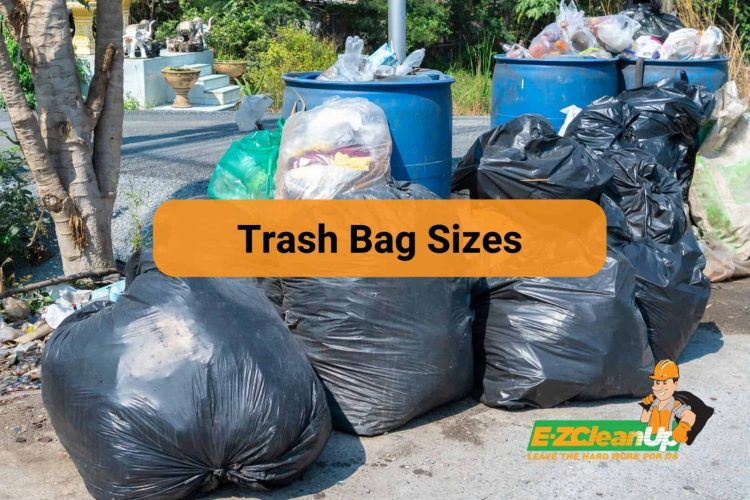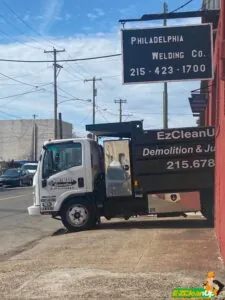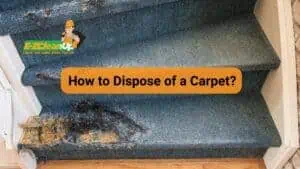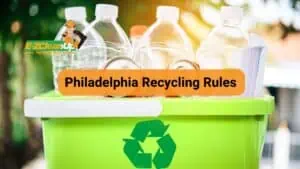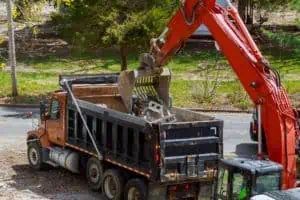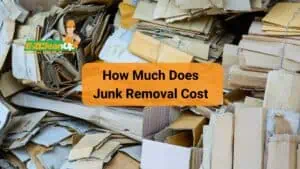Trash bag sizes typically range from small (4-8 gallons) for bathroom bins to medium (13-30 gallons) for kitchen use and large (33-55 gallons) for outdoor or heavy-duty tasks.
Selecting the right trash bag size helps in managing waste better. A bag that’s too big can be wasteful, and one that’s too small may break or spill. Let’s learn more details about trash bag sizing and how to choose the right one suited for your needs.
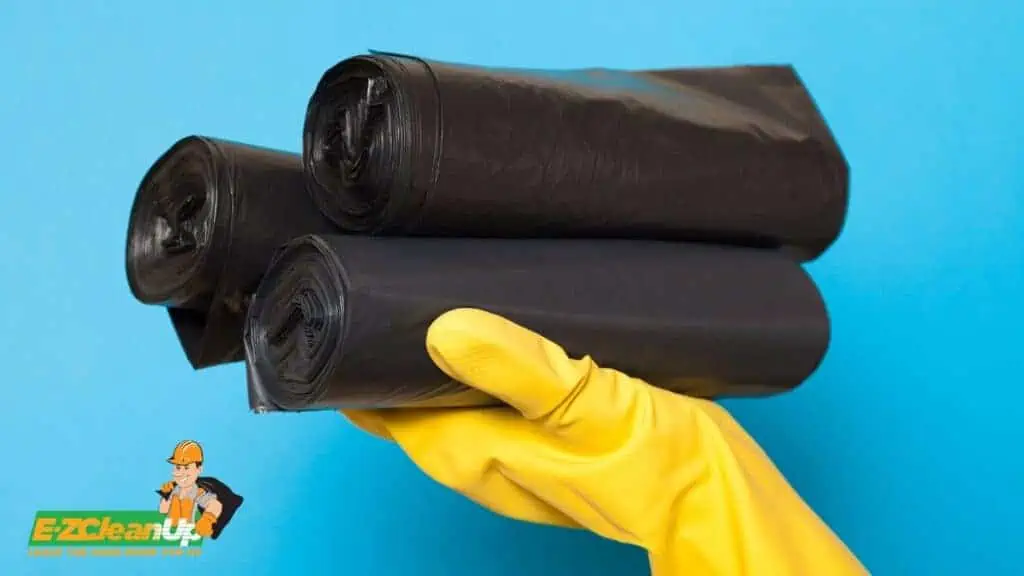
The Basics of Trash Bag Sizing
Trash bag sizes are usually determined by their volume capacity (how much they can hold) and their physical dimensions (length and width). Volume is typically measured in gallons or liters, a critical factor in assessing the amount of trash the bag can accommodate. Dimensions are key in ensuring the bag fits well in your trash can or waste bin. For example, a bag that is 24 inches wide and 33 inches tall will fit into a standard kitchen trash bin.
Thickness is another important measurement, usually given in mils (one-thousandth of an inch) or microns. Thicker bags are more durable and resistant to punctures or tears, making them suitable for heavier or sharper waste materials.
Common Size Classifications
To make it easier to remember trash bag sizes, you can use size classifications in gallons and liters as references. Residential bags typically range from 4 to 13 gallons, suitable for bathroom and office wastebaskets. Standard kitchen trash bags are around 13 to 30 gallons. In commercial or industrial settings, larger sizes, such as 33 gallons and up, are common, which can accommodate bigger bins and heavier waste loads.
For the European market and metric system users, bags are often labeled in liters, with common sizes including 30, 60, 120, and up to 240 liters for larger bins and industrial use.
Interpreting Bag Size Labels
When reading a trash bag’s label, both the volume capacity and the bag’s physical dimensions provide crucial information. The volume indicates the maximum amount of waste the bag can handle, guiding you on how frequently it needs replacing. Dimensions are essential for fitting the bag snugly into your bin without excess material hanging over or the bag being too tight to insert.
Labels might also indicate specific uses (e.g., “yard waste,” “recyclables”) or special features (e.g., drawstrings, odor control, reinforced bottoms). Recognizing these features can guide you in choosing bags that are tailor-made for your specific requirements, whether for regular household waste, yard debris, or more specialized needs like construction debris cleanup.
By understanding these basics, consumers and businesses can make informed decisions about which trash bags are best for their particular situations. They can balance factors like capacity, durability, fit, and special features against their specific waste disposal and management needs.
Types of Trash Bags
Trash bags come in different types, depending on where you intend to use them:
General Usage
Low-pressure polyethylene bags are commonly utilized for gathering and disposing of household waste in homes, offices, and other facilities. These bags are also suitable for packaging smaller items. Their capacity typically ranges from 20, 30, and 60 to 120 liters, which makes them suited for everyday disposal needs.
Versatile Polyethylene Bags
For storing and transporting solid, dry materials like packing elements, fertilizers, and soils, bags made from polyethylene are ideal. They are also effective for carrying light construction debris. These bags vary in size, from smaller dimensions like 15×20 cm to larger sizes up to 150×220 cm.
PP Bags for Construction
PP (Polypropylene) bags are particularly designed for hauling bulk construction debris, offering durability and capacity for heavy loads.
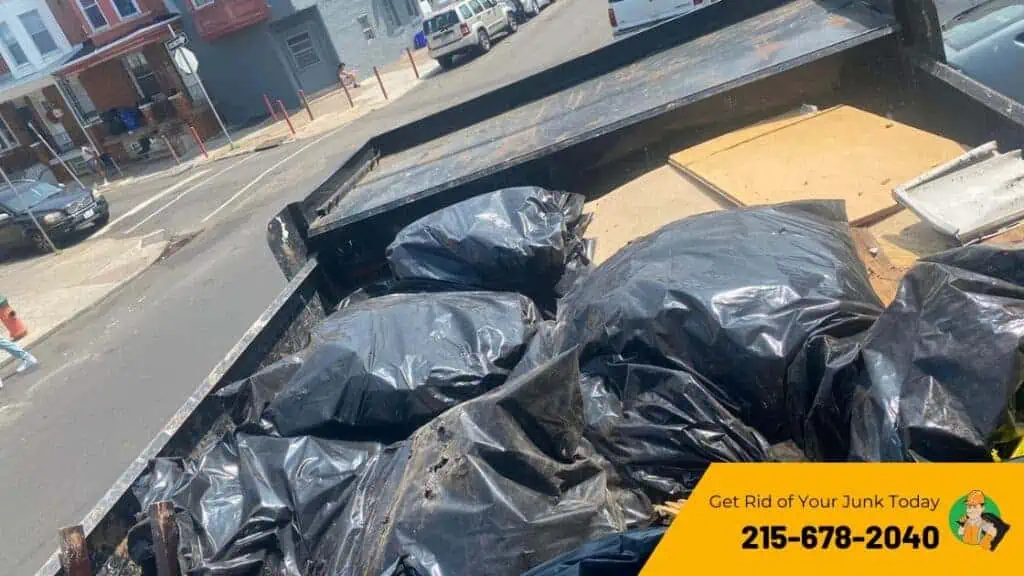
Choosing the Right Trash Bag Size Made Easy
Consider the following when choosing trash bags:
Household Use Cases
Here are the typical sizes in this category, depending on usage:
Small Trash Bags for Bathroom and Office Waste
Small trash bags typically range from 4 to 8 gallons and are ideal for bathroom wastebaskets or small office bins. They’re perfect for containing tissues, paper towels, and other light waste. Their compact size means they fit well in smaller trash receptacles without unnecessary overhang or bulk.
Medium-Sized Bags for Kitchen and General Use
Medium-sized trash bags, generally around 13 to 30 gallons, are the go-to choice for kitchen waste bins. They have sufficient capacity for daily kitchen debris like food scraps, packaging, and general household trash. The size ensures they handle a good amount of waste while still being easy to tie up and carry.
Large Trash Bags for Outdoor and Heavy-Duty Applications
Large trash bags, often 33 gallons and above, are designed for outdoor and heavy-duty tasks. They are essential for yard work, collecting leaves, and other garden debris. These bags are also suitable for larger family gatherings or extensive cleaning projects where a substantial amount of waste is generated. Their strength and larger volume capacity make them practical for bulky or heavier waste materials.
Factors to Consider When Choosing Bag Size
Selecting the right trash bag size is not just about convenience; it’s also about efficiency and suitability for the type of waste and bin you’re dealing with.
The Size of Your Trash Can or Bin
The correct bag size for your trash can or bin is crucial. To determine the right size, measure the circumference of your trash can and compare it to the dimensions of the bag. Ideally, the bag should be large enough to cover the can’s rim and have enough excess to fold over or tie up when full.
Frequency of Trash Disposal
Your trash disposal habits can influence the ideal bag size. Frequent disposers, like those in high-traffic household kitchens, may find that smaller bags (13 to 20 gallons) are sufficient and more hygienic, as the trash won’t sit long enough to decompose and create odors. For those disposing of waste less often, perhaps in lower-traffic areas or single-person homes, a larger bag (20 to 30 gallons) can be more practical, reducing the frequency of bag changes.
Types of Waste You Generate
The nature of the waste being disposed of significantly impacts the choice of trash bag size and type:
- Kitchen Waste: Often wet and heavy, kitchen waste requires a medium-sized, sturdy bag (typically 13 to 30 gallons) with good tear and leak resistance.
- Yard Waste: For garden or yard debris like leaves, branches, or grass clippings, larger and more durable bags (30 gallons and up) are necessary. These bags need to handle sharp twigs and heavier loads without tearing.
- Office or Light Waste: In spaces like offices, where the trash is mostly paper and light packaging, smaller, lighter bags (4 to 13 gallons) are usually sufficient.
- Specialized Waste: For construction debris, pet waste, or other specialized types, consider both size and material strength.
Tips for Efficient Trash Bag Usage
Effective trash bag usage makes managing household waste easier and helps in maintaining cleanliness and preventing spills. Here are some tips to maximize efficiency:
Techniques for Fitting Bags Securely in Trash Cans
- Choose the Right Size: Make sure the bag matches the size of your trash can. It should cover the rim and extend a few inches outside or over the top.
- Stretching the Rim: Gently stretch the opening of the bag before placing it in the can. This ensures a snug fit and prevents the bag from slipping inside.
- Air Out: Before fitting the bag, inflate it slightly to ensure all corners are expanded. This helps the bag fit neatly and use its full capacity.
- Secure with an Elastic Band: If the bag tends to slip, use a large rubber band or specially designed trash can straps to secure it around the rim.
Preventing Overfilling and Bag Tears
- Know the Limit: Be mindful of the bag’s fill limit, both in terms of weight and volume. Overfilling increases the risk of tears and makes the bag hard to seal.
- Distribute Weight Evenly: Place heavier items at the bottom and lighter, bulkier waste on top. This prevents stress points that can tear the bag.
- Sharp Object Precaution: Wrap sharp objects like bones, glass, or metal edges in paper or other waste to prevent them poking through the bag.
- Monitor for Punctures: Regularly check the exterior of the bag for punctures or weaknesses, especially when disposing of heavy or sharp items.
Knot-Tying and Sealing Methods
Adopting these techniques can greatly enhance the utility and effectiveness of your trash bags and make waste management in your home or office simpler and easier:
- Twist and Tie: The simplest method is to twist the top of the bag and tie a knot. Ensure there’s enough space at the top to do this without spilling the contents.
- Bag Ties and Clips: Use bag ties, twist ties, or clips provided with most trash bags for a secure seal.
- Double Bagging: For particularly heavy or sharp waste, consider using two bags, one inside the other, for extra strength and leak prevention.
- Overhand Knot: For larger bags, an overhand knot can be more effective. Gather the top of the bag, make a loop, and pass the end through, pulling tightly.
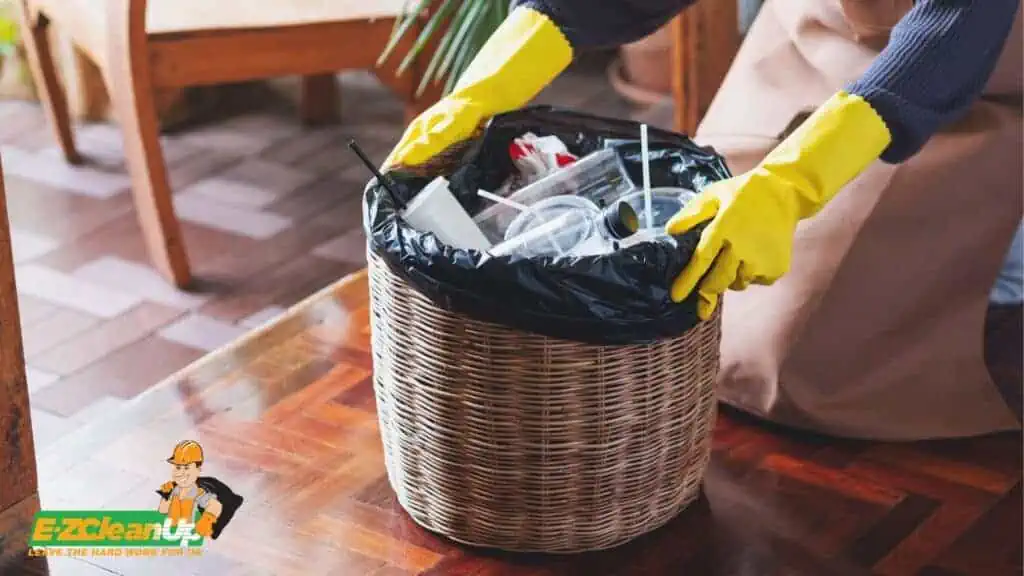
How to Properly Dispose of Trash Bags
Proper disposal of trash bags is crucial for environmental safety and public health. Here are some guidelines to ensure responsible and safe disposal:
Recycling and Disposing of Plastic Bags Responsibly
- Check Local Guidelines: Recycling rules vary by location. Some areas have dedicated facilities for plastic bags, while others may not accept them in curbside recycling.
- Drop-off Locations: For areas where curbside recycling of plastic bags isn’t available, look for local grocery stores or recycling centers that offer plastic bag collection.
- Avoid Contamination: Ensure that bags are empty, clean, and dry before recycling. Contaminated bags can interfere with the recycling process.
- Reuse Options: Consider reusing trash bags when possible, particularly if they’re clean and in good condition.
Safe Handling of Potentially Hazardous Waste
- Identify Hazardous Waste: Items like batteries, electronic waste, chemicals, and paint shouldn’t be disposed of in regular trash bags. They require special handling to prevent harm to the environment and people.
- Use Appropriate Containers: For hazardous materials, use containers designated for such waste. Follow local guidelines for disposal.
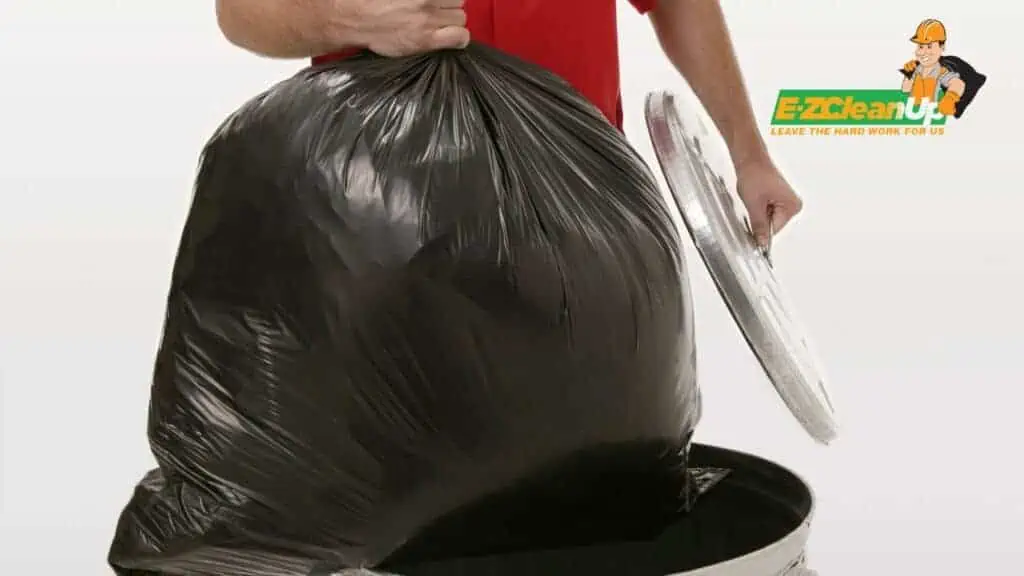
FAQs – Trash Bag Sizes
Can I Use a Slightly Larger Trash Bag than My Bin’s Size?
Yes, you can use a bag that’s slightly larger. It might provide extra coverage and ensure that the bag doesn’t slip inside the bin. However, avoid using excessively large bags to prevent wastage.
Are there Biodegradable or Eco-Friendly Trash Bags Available in Various Sizes?
Yes, eco-friendly trash bags, including biodegradable and compostable options, are available in many sizes. They may be priced higher than regular trash bags, but they are a great choice for environmentally conscious waste disposal.
How Can I Prevent My Trash Bag from Slipping Down into the Bin?
Choose a bag that fits your bin’s size. Additionally, some bags come with drawstrings or elastic bands that help secure them to the rim of the bin to prevent slippage. You can also look for bags with gripping materials on the outer surface for a better hold.
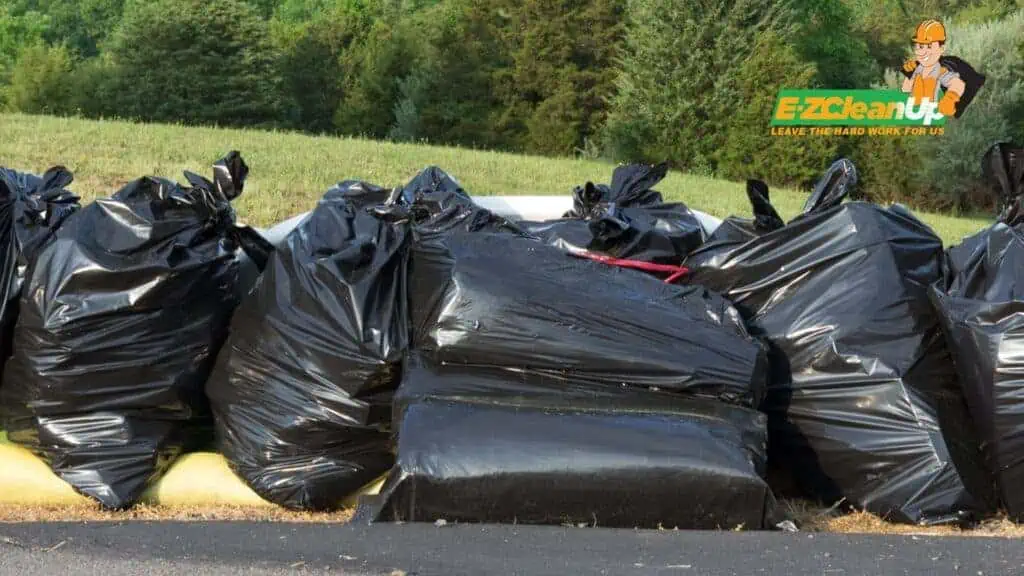
Conclusion
Selecting the right trash bag size is crucial for effective waste management. Whether it’s for small office bins, larger kitchen containers, or heavy-duty outdoor use, understanding the dimensions and capacity of your trash bags ensures cleanliness and convenience.
Factor in your trash can size, the type of waste, and disposal frequency to make the best choice. Use secure fitting techniques to prevent slips and spills, and always dispose of bags responsibly while keeping an eye on recycling and proper handling of hazardous waste.
After a thorough decluttering and cleanout session, when you find yourself with various sizes of trash bags filled with junk, especially if you’re in the Philly or surrounding areas, consider hiring EZ CleanUp. We specialize in removing all kinds of junk. Be it a cluttered garage brimming with years’ worth of stuff or an attic filled with heavy, bulky items, like old mattress, couch, and furniture, we’re here to help.
At EZ CleanUp, we’re dedicated to providing quick, efficient service and making sure your trash is disposed of in an eco-friendly way. We’ll even pick up your unwanted items, even if they’re not in trash bags. Call us to learn more about our services and how we can help with your junk removal needs.

